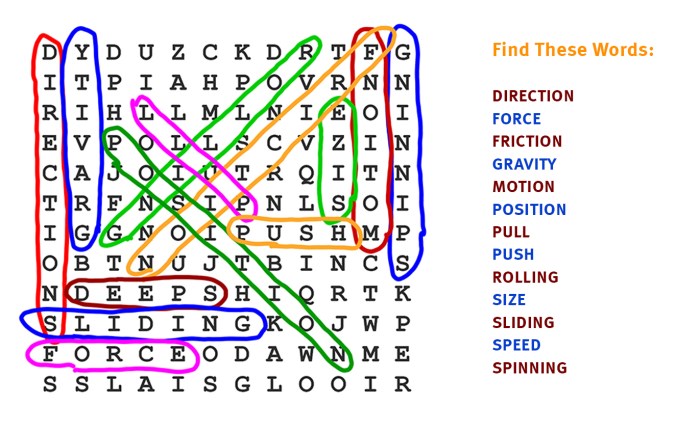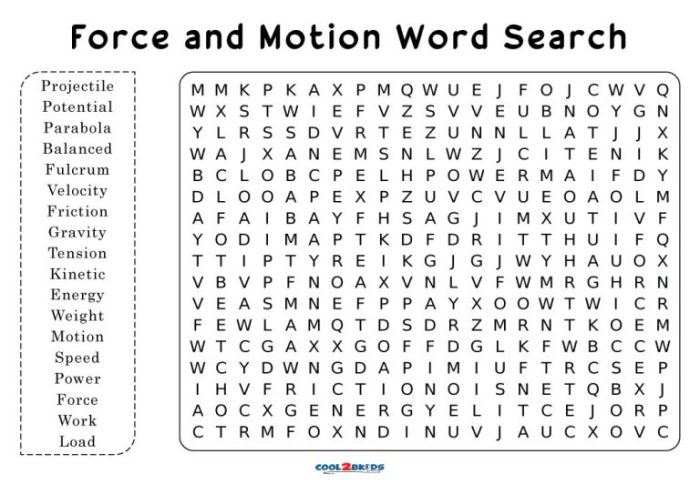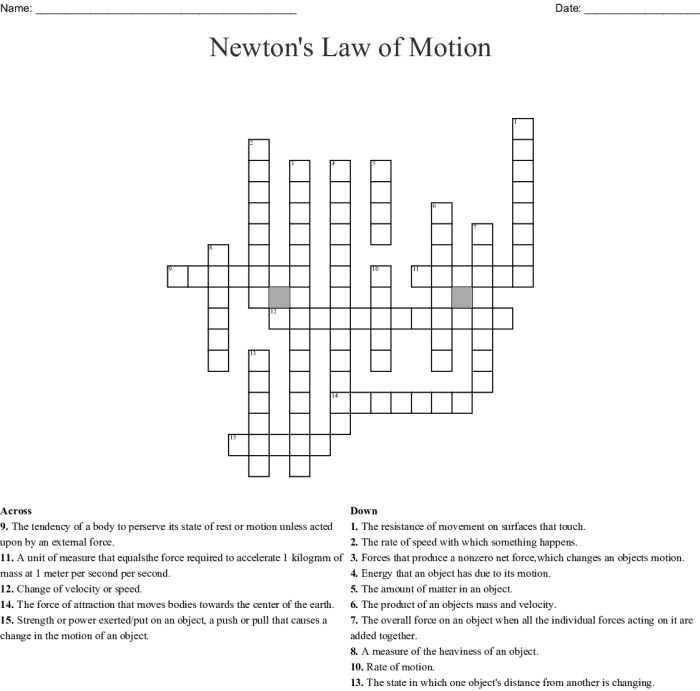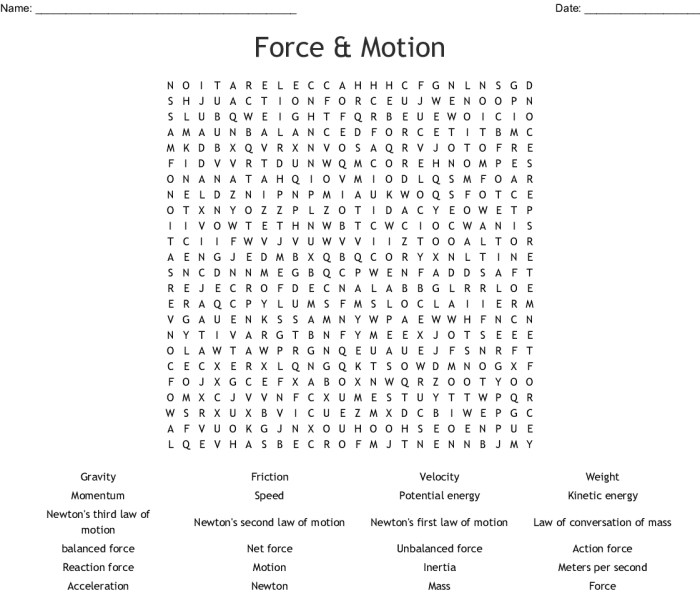Embark on a journey into the realm of force and motion, where the force and motion word search answers unveil the intricate relationship between these fundamental concepts. From defining key terms to exploring practical applications, this comprehensive guide empowers you to navigate the dynamic world of physics with confidence.
Force and Motion Word Search Vocabulary

Understanding the fundamental concepts of force and motion is essential for comprehending the physical world around us. To enhance your understanding, let’s explore the key terms that frequently appear in force and motion word searches, providing clear definitions for each.
These terms form the foundation of classical mechanics, enabling us to describe and analyze the behavior of objects in motion.
Key Terms and Definitions, Force and motion word search answers
- Force:An interaction that can change the motion of an object. Forces can be applied in different directions, causing objects to accelerate, decelerate, or change direction.
- Motion:The change in position of an object over time. Motion can be described in terms of speed, velocity, and acceleration.
- Speed:The rate at which an object covers distance, typically measured in meters per second (m/s).
- Velocity:The rate at which an object covers distance in a specific direction, typically measured in meters per second (m/s) in a particular direction.
- Acceleration:The rate at which an object’s velocity changes, typically measured in meters per second squared (m/s²).
- Mass:A measure of the amount of matter in an object, typically measured in kilograms (kg).
- Weight:The force exerted on an object due to gravity, typically measured in newtons (N).
- Friction:A force that opposes the relative motion of two surfaces in contact, typically measured in newtons (N).
- Gravity:A fundamental force that attracts objects with mass towards each other, typically measured in newtons (N).
- Inertia:The tendency of an object to resist any change in its motion, whether at rest or in motion.
Identifying Forces and Motion

Forces and motion are two fundamental concepts in physics. Forces can cause objects to move, stop moving, or change direction. Motion can be described in terms of speed, velocity, and acceleration.
Types of Forces
There are many different types of forces, including:
- Contact forcesare forces that occur when two objects are in contact with each other. Examples of contact forces include friction, tension, and normal force.
- Non-contact forcesare forces that occur between two objects that are not in contact with each other. Examples of non-contact forces include gravity and magnetism.
- Applied forcesare forces that are applied to an object by an external source. Examples of applied forces include pushing, pulling, and lifting.
How Forces Affect Motion
Forces can affect motion in a variety of ways. For example, a force can:
- Change the speed of an object. A force can cause an object to speed up, slow down, or stop moving.
- Change the direction of an object. A force can cause an object to change direction, either by turning it or by making it move in a different direction.
- Change the acceleration of an object. A force can cause an object to accelerate, decelerate, or change direction of acceleration.
Relationship Between Force and Motion
The relationship between force and motion can be summarized in the following table:
| Force | Motion | Relationship |
|---|---|---|
| Applied force | Change in speed, direction, or acceleration | The greater the force, the greater the change in motion. |
| Contact force | Friction, tension, normal force | Contact forces can oppose or assist motion. |
| Non-contact force | Gravity, magnetism | Non-contact forces can attract or repel objects, causing them to move. |
Solving the Word Search Puzzle

To effectively solve a force and motion word search, follow these steps:
- Scan the Puzzle:Quickly scan the puzzle to familiarize yourself with the layout and identify any obvious words.
- Look for Common Words:Begin by searching for short, common words like “force,” “motion,” or “speed.”
- Use Word Lists:Refer to a list of force and motion terms to guide your search. Focus on finding words related to force (e.g., gravity, friction) and motion (e.g., velocity, acceleration).
- Search Horizontally and Vertically:Move systematically through the puzzle, searching for words in both horizontal and vertical directions.
- Look for Intersections:Pay attention to where words intersect. Often, one letter can be part of multiple words.
- Eliminate Used Letters:As you find words, cross out the letters used to avoid confusion.
- Guess and Check:If you get stuck, make educated guesses based on the remaining letters and the context of the puzzle.
To enhance your efficiency, consider using these strategies:
- Divide the Puzzle into Sections:Break the puzzle into smaller sections to make it more manageable.
- Use a Pencil and Paper:Keep a pencil and paper handy to write down potential words and cross out used letters.
- Take Breaks:Step away from the puzzle periodically to clear your mind and return with a fresh perspective.
Sample Word Search Puzzle
To practice, here is a sample word search puzzle with hidden force and motion terms:
| E | S | P | E | E | D | F | R | I | C | T | I | O | N |
| A | C | C | E | L | E | R | A | T | I | O | N | R | A |
| M | O | T | I | O | N | E | W | T | O | N | M | O | M |
| O | F | R | I | C | T | I | O | N | F | O | R | C | E |
| T | I | O | N | I | T | I | A | L | A | C | C | E | L |
| I | N | E | R | T | I | A | F | O | R | C | E | S | S |
| A | C | C | E | L | E | R | A | T | I | O | N | R | A |
| V | E | L | O | C | I | T | Y | E | F | O | R | C | E |
| E | L | O | C | I | T | Y | R | E | S | I | S | T | A |
| L | O | C | I | T | Y | D | I | S | P | L | A | C | E |
| O | M | A | S | S | T | E | R | T | I | A | R | C | E |
Hidden Words:
- Acceleration
- Force
- Friction
- Inertia
- Mass
- Motion
- Velocity
Applications of Force and Motion: Force And Motion Word Search Answers

Understanding the principles of force and motion is essential in various fields. It provides the foundation for technological advancements, engineering marvels, and scientific discoveries.
In everyday life, we encounter countless applications of force and motion. From the simple act of walking to operating machinery, these principles govern our interactions with the world around us.
Examples from Everyday Life
- Driving a car: Understanding the forces acting on a vehicle, such as friction, gravity, and air resistance, is crucial for safe and efficient driving.
- Playing sports: Athletes utilize force and motion to propel themselves, control their movements, and interact with equipment.
- Construction: Engineers apply force and motion principles to design and build structures that can withstand various forces, such as earthquakes and wind loads.
Applications in Science and Engineering
- Rocket propulsion: Understanding the principles of force and motion is essential for designing and launching rockets into space.
- Medical imaging: MRI (Magnetic Resonance Imaging) and CT (Computed Tomography) scanners utilize magnetic and X-ray forces to generate detailed images of the human body.
- Robotics: Engineers apply force and motion principles to design and control robots that can perform complex tasks, such as manufacturing and exploration.
Clarifying Questions
What are the key terms related to force and motion?
Force, motion, velocity, acceleration, friction, gravity
How do forces affect motion?
Forces can change an object’s speed, direction, or both.
What are some practical applications of understanding force and motion?
Engineering design, sports performance analysis, medical rehabilitation

